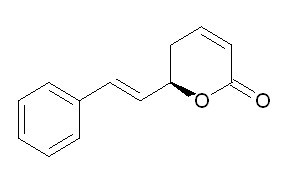| Applications | Goniothalamin (GTN), a plant bioactive styryl-lactone, is a natural product with potent anti-tumorigenesis effects for several types of cancer. Nonetheless, the anticancer effect of GTN has not been examined in oral cancer. The present study was designed to evaluate its potential anticancer effects in an oral squamous cell carcinoma (OSCC) model and to determine the possible mechanisms with respect to apoptosis, DNA damage, reactive oxygen species (ROS) induction, and mitochondrial membrane potential. Our data demonstrated that cell proliferation was significantly inhibited by GTN in Ca9-22 OSCC cancer cells in concentration- and time-dependent manners (p<0.05). For cell cycle and apoptotic effects of GTN-treated Ca9-22 cancer cells, the sub-G1 population and annexin V-intensity significantly increased in a concentration-dependent manner (p<0.001). For the analysis of DNA double strand breaks, γH2AX intensity significantly increased in GTN-treated Ca9-22 cancer cells in concentration-response relationship (p<0.05). Moreover, GTN significantly induced intracellular ROS levels in Ca9-22 cancer cells in a concentration- and time-dependent manner (p<0.05). For membrane depolarization of mitochondria, the DiOC(2)(3) (3,3'-diethyloxacarbocyanine iodide) intensity of GTN-treated Ca9-22 cancer cells was significantly decreased in concentration- and time-dependent relationships (p<0.001). Taken together, these results suggest that the anticancer effect of GTN against oral cancer cells is valid and GTN-induced growth inhibition and apoptosis influence the downstream cascade including ROS induction, DNA damage, and mitochondria membrane depolarization. Therefore, GTN has potential as a chemotherapeutic agent against oral cancer.
The purpose of this study was to examine and characterize the in vitro cytotoxicity effect of goniothalamin on the human hepatocellular carcinoma HepG2 cells and normal liver Chang cells and also to study the morphological and biochemical changes of goniothalamin-treated HepG2 and Chang cells. Goniothalamin (2.3 -150 μM; 24, 48 and 72 hours) treatment to HepG2 and Chang cells resulted in a dose and time dependent inhibition of cell growth as assessed by MTT and LDH assays. The data suggest that goniothalamin selectively inhibits HepG2 cells (IC50 of MTT= 4.6(±0.23) μM; IC50 of LDH= 5.20(±0.01) μM for 72 hours) with less inhibition of growth in Chang cells (IC50 of MTT= 35.0(±0.09) μM; IC50 of LDH= 32.5(± 0.04) μM for 72 hours. The cytotoxic activity of goniothalamin on HepG2 cells was confirmed by Trypan blue dye exclusion assay. Goniothalamin reduced the number of viable cells (non-stained) associated with an increase on the number of non-viable cells (stained) and the Viability Indexes were 52 ± 1.73% for HepG2 cells and 62 ± 4.36% for Chang cells at IC50 after 72 hours. Cells were exposed to goniothalamin at lowest concentration (2.3 μM), IC50 (of MTT results), and highest concentration (150 μM) for 24, 48, or 72 hours and then examined for effects on cell cycle (using the flow cytometry) or proliferation (using the BrdU ELISA assay). The cytotoxic activity of goniothalamin was related to the inhibition of DNA synthesis, as revealed by the reduction of BrdU incorporation. At 72 hours with the lowest goniothalamin concentration of 2.3 μM, the normal liver Chang cells retained 97.6% of control proliferation while the liver cancer HepG2 cells were reduced to 19.8% of control proliferation. Goniothalamin caused the accumulation of hypodiploid apoptotic cells in cell cycle analysis by flow cytometry. Goniothalamin arrested HepG2 and Chang cells in the G2/M phase with different degrees. Light microscopy examination of HepG2 and Chang cells exposed to different concentrations of goniothalamin up to 72 h demonstrated changes in cellular morphology; i.e. cell rounding followed by a loss of adherence with subsequent cell shrinkage and blebbing. In addition, the apoptotic cells were more abundant in goniothalamin-treated HepG2 cells (84 ± 4.58%) for 72 hours than in untreated cell (4 ± 2.65%) upon measurement by TUNEL staining. In view of the toxicity of goniothalamin, the kind of cell death, namely apoptosis or necrosis, was assessed. Therefore, staining with fluorescence labeled annexin V in combination with propidium iodide was performed on HepG2 and Chang cells exposed to goniothalamin. The laser scanning cytometry of propidium iodide and annexin V-stained cells indicated that the growth inhibiting effect of goniothalamin was consistent with a strong induction of apoptosis at late stage. This is because the cellular membrane integrity was lost, so the cells exhibited annexin V- and propidium iodidedouble positive up to 85.87 ± 0.78 and 57.69 ± 1.12 in HepG2 and Chang cells after 24 hours, respectively. In order to confirm apoptotic mechanism in the goniothalamintreated cells, caspase 3 activity upon the same treatment conditions was carried out. The results indicate that caspase 3 activity was significantly elevated early in IC50 treated Chang cells (574% of control) after 24 hours and late in IC50 treated cells after 72 hours in HepG2 cells (879% of control). Our findings suggest a potential mechanism for the strong growth inhibitory effect of goniothalamin on this HepG2 liver cancer cells. However, less sensitivity to normal liver Chang cell line was observed by this compound. An important feature of the cytotoxicity by goniothalamin is that it is mediated through apoptosis.
|


